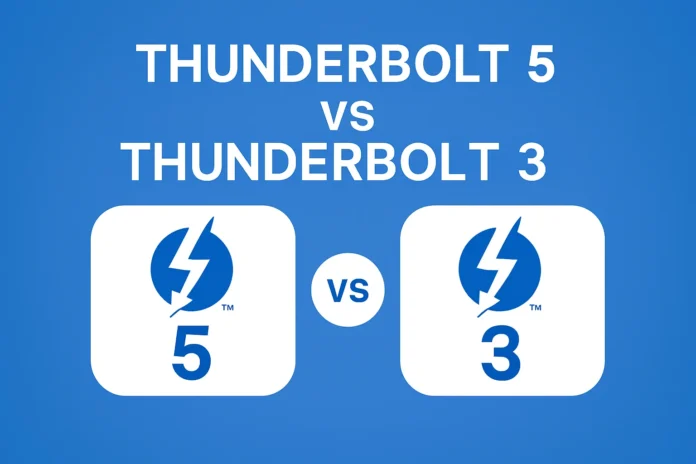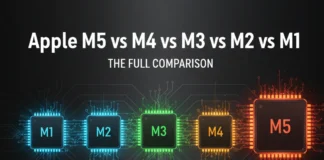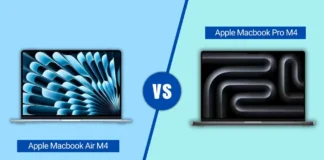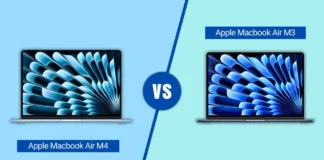Ten years can make a lot of difference in technology, and nowhere is that more evident than with Thunderbolt ports.
When it launched in 2015, Thunderbolt 3 moved at lightning speed, giving us a single cable for data, video, and power. But in 2025, Thunderbolt 5 takes this idea to a whole new level.
In this guide, we’ll detail how Thunderbolt 5 is better than Thunderbolt 3, what these upgrades mean for everyday use, and whether it’s worth making the switch. Whether you’re a content creator, a gamer, or someone who just wants to improve their setup, you’ll see what’s changed and why it matters.
Table of Contents
Thunderbolt 5 vs Thunderbolt 3 – Quick Comparison
| Feature / Spec | Thunderbolt 3 | Thunderbolt 5 | Real-World Impact | ????Winner |
| Maximum Bandwidth | 40 Gbps (bi-directional) | 80 Gbps (bi-directional), up to 120 Gbps in special mode | Transfers large files in half the time and supports smoother multi-monitor setups | Thunderbolt 5 |
| PCIe Data Speed | PCIe 3.0 x4 (32 Gbps) | PCIe 4.0 x4 (64 Gbps) | Faster NVMe SSD and external GPU performance | Thunderbolt 5 |
| External SSD Speed | Around 2,800 MB/s | Around 6,700 MB/s | Huge speed boost for 4K/8K video editing and large backups | Thunderbolt 5 |
| 4K Display Support | Up to 2 monitors @ 60Hz | Up to 3 monitors @ 144Hz | More screens at higher refresh rates for better multitasking | Thunderbolt 5 |
| 8K Display Support | 1 monitor @ 60Hz | 2 monitors @ 60Hz or 1 @ 120Hz | Smoother visuals for creative pros and gamers | Thunderbolt 5 |
| Charging Power | Up to 100W | Up to 240W | Powers bigger laptops without a separate charger | Thunderbolt 5 |
| Cable Length (Passive) | Up to 0.8m at full speed | Up to 1m at full speed | Slightly more flexibility in desk setups | Thunderbolt 5 |
| Backward Compatibility | Works with TB1, TB2 (with adapter), USB4, USB 3.2 | Works with TB3, TB4, USB4 v2, USB 3.2 | No need to replace all your accessories | Tie |
| Device Availability (2025) | Widespread on mid to high-end devices | Mostly in premium devices | TB3 is easier to find and more budget-friendly | Thunderbolt 3 |
| Best For | Everyday productivity and standard creative work | High-end creative workflows, gaming, and future-proofing | Choose based on your performance needs | Depends |
Also Read:
- Thunderbolt 5 vs Thunderbolt 4: Specs, Speed Tests & Upgrade Guide
- Thunderbolt 4 vs. Thunderbolt 3: What’s the Difference?

Looking at the table above, Thunderbolt 5 is clearly aimed at people who push their hardware to the limit. If you mostly browse the web, stream videos, or use office apps, Thunderbolt 3 is still more than enough.
Where Thunderbolt 5 really pulls ahead is in tasks that move a lot of data or need serious display power. For example, video editors working with 8K footage will notice transfers finishing in nearly half the time. Gamers can enjoy high refresh rates on multiple monitors without feeling like the system is struggling to keep up.
The upgrade from PCIe 3.0 in Thunderbolt 3 to PCIe 4.0 in Thunderbolt 5 doubles available throughput, unlocking much faster SSD and GPU performance. Thunderbolt 5’s speed can save you minutes on every transfer. That adds up quickly if you do it daily.
Power delivery is another area where the upgrade matters. Thunderbolt 5 can push up to 240W, enough to run and charge power-hungry gaming laptops or workstations through a single cable. That means fewer bulky chargers and less desk clutter.
That said, not everyone needs these upgrades right now. If your workflow is already smooth and you don’t use multiple 4K or 8K displays, Thunderbolt 3 can still keep up just fine. But if you’re buying new hardware and want something ready for the next decade of tech demands, Thunderbolt 5 is the smarter long-term choice.
Thunderbolt 3 Overview & Limitations
When Thunderbolt 3 launched in 2015, it was a game-changer. For the first time, we had a tiny USB-C port that could handle data, video, and power all on a single cable. You no longer needed to juggle multiple connections for monitors, storage drives, and chargers.
Thunderbolt 3’s bandwidth reaches 40Gbps, which was a phenomenal feat in 2015, but now it limits complex workflows like connecting multiple 8K displays or high-speed storage, or even connecting to an external GPU for better graphics. For creative professionals and power users of the time, it was magic.
But nowadays some of Thunderbolt 3’s limits are starting to show:
- Lower Display Support – Thunderbolt 3 monitor support includes up to two 4K displays at 60Hz or a single 8K display, which remains sufficient for most office setups.
- Slower PCIe Speeds – Uses PCIe 3.0 x4, which caps external SSD performance around 2,800 MB/s. Great for 2015, but slower by modern standards.
- Lower Power Delivery – Can charge laptops up to 100W, which is fine for ultrabooks but not enough for today’s power-hungry gaming and workstation laptops.
- Older Cable Standard – Passive cables longer than 0.8m drop speed, making setups less flexible.
Thunderbolt 3 is still an excellent standard for everyday productivity and even moderate creative tasks. But if you’re working with 8K video, running multiple high-refresh monitors, or regularly transferring large files, you’ll quickly understand why the upgrade to Thunderbolt 5 makes sense.
Also Read: Best Gaming Laptops with Thunderbolt 3
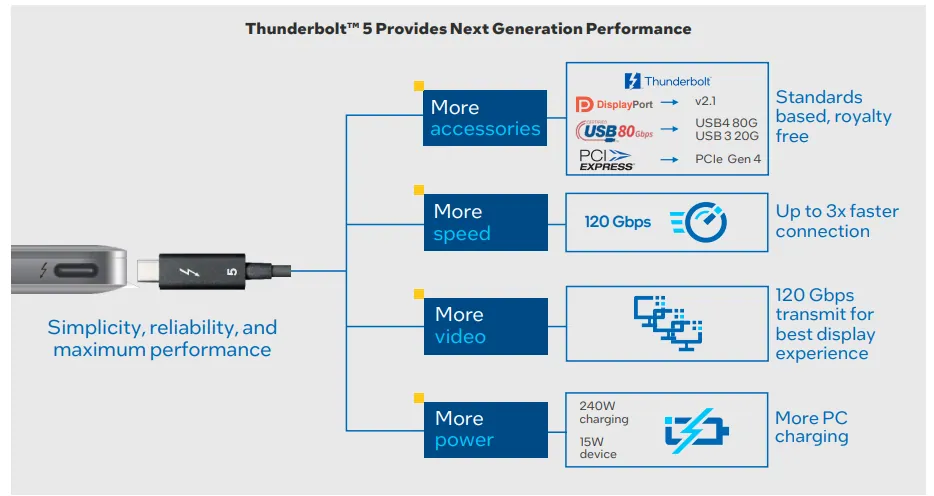
Thunderbolt 5 Overview & Key Upgrades
Thunderbolt 5, which will be officially announced in late 2023 and available in laptops in early 2024, brings a significant boost in performance over Thunderbolt 3. This is no small speed increase. It’s designed for the kind of heavy workloads that modern professionals, gamers, and content creators face every day.
1. Double the Bandwidth
Thunderbolt 5 delivers 80 Gbps of bi-directional bandwidth. In a special mode called Bandwidth Boost, it can reach up to 120 Gbps in one direction.
Example: If you are editing 8K video across multiple monitors, Thunderbolt 5 moves data between your computer and displays fast enough to keep everything smooth without stutter.
2. Faster PCIe Speeds for Storage and GPUs
Thunderbolt 5 uses PCIe 4.0 instead of PCIe 3.0. This doubles SSD transfer speeds, and roughly halves export times in editing software like Davinci Resolve. Plus, it also doubles data throughput, from 32 Gbps to 64 Gbps.
Example: An external NVMe SSD can now reach speeds of around 6,700 MB/s, compared to about 2,800 MB/s on Thunderbolt 3. That means a huge video project that once took 2 minutes to copy could now take less than 1 minute.
3. Stronger Multi-Monitor Support
Thunderbolt 5 can run up to three 4K monitors at 144Hz, or two 8K monitors at 60Hz, or even one 8K monitor at 120Hz. This is possible because it integrates DisplayPort 2.1 for improved video handling.
Example: Gamers can enjoy triple high-refresh 4K displays, while video editors get massive workspace for multiple timelines and tools.
4. Much Higher Power Delivery
Thunderbolt 5 power delivery reaches up to 240W, enabling even the most demanding laptops to charge and run through a single cable through USB Power Delivery 3.1.
Example: A high-performance gaming laptop that once needed a bulky charger can now run and charge through the same cable that handles video and data.
5. Improved Cable Technology
It uses PAM-3 signaling to reach full speed over passive cables up to 1 meter long, without requiring expensive active cables. It still works with Thunderbolt 3 and 4 cables for standard speeds.
6. Faster Networking
Thunderbolt Networking bandwidth has doubled from 10 Gbps to 20 Gbps. This makes PC-to-PC transfers much faster, which is great for teams working on large projects together.
7. Backward Compatibility
Thunderbolt port compatibility remains excellent, working with devices and cables that are Thunderbolt 5, Thunderbolt 3, Thunderbolt 4, and USB4. You can use your existing docks, drives, and monitors, and they will run at their maximum supported speeds.
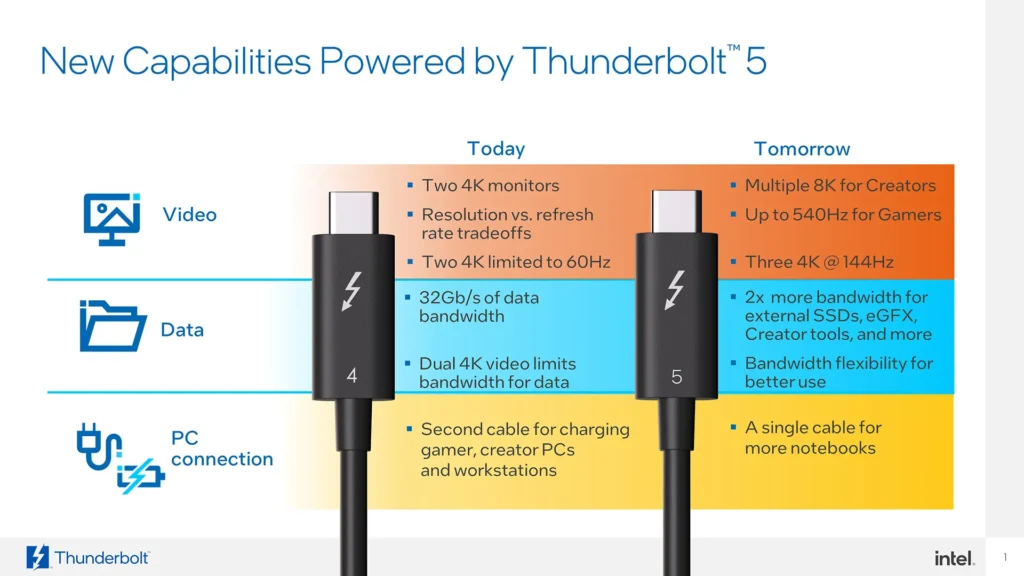
Real-World Uses for Thunderbolt 5
Thunderbolt 5 isn’t just a spec bump — it genuinely changes what you can do.
- Video Editing & Content Creation – Handles 8K or high-bitrate 4K footage faster, with smoother multi-monitor editing and exports up to 40% quicker than TB3.
- Gaming on Multiple High-Refresh Displays – Run up to three 4K monitors at 144Hz with lower input lag, perfect for eSports and immersive setups.
- 3D & CAD Work – Faster rendering and large project transfers for architects, engineers, and designers — up to 35% speed boosts over TB3.
- High-Speed Backup – Move terabytes in minutes; 1TB in under 3 mins vs 6+ mins on TB3.
- Docking & Workstations – One TB5 hub handles multiple monitors, storage, and networking without slowdowns.
- Laptop Charging – Up to 240W power delivery charges high-performance laptops fast.
- Team Collaboration – 20Gbps PC-to-PC transfers make sharing massive files quick and seamless.
Thunderbolt 5 vs Thunderbolt 3: Devices & Pricing (2025)
Thunderbolt 5 is primarily found in premium laptops, desktops, and high-speed accessories in 2025. Thunderbolt 3, on the other hand, remains widely available, affordable, and sufficient for everyday productivity and moderate creative tasks. Here’s a quick overview of devices, pricing, and pros & cons for both standards.

Thunderbolt 5 Devices
| Device | Type | TB Ports | Price / Start |
| Apple MacBook Pro 16 (M4 Pro / M4 Max) | Laptop | 2 | $2,499 |
| ASUS ROG Strix G16 (2025) | Laptop | 2 | TBD |
| Razer Blade 18 (2025) | Laptop | 2 | TBD |
| ASUS ROG Flow Z13 (2025) | Laptop | 1 | TBD |
| Acer Predator Helios 16 & 18 | Laptop | 2 | TBD |
| Alienware 16 & 18 Area-51 | Laptop | 2 | TBD |
| MSI Vector & Raider Series 16/18 HX AI | Laptop | 2 | TBD |
| Lenovo Legion 9 18 | Laptop | 2 | TBD |
| Apple Mac Studio (M4 Max / M3 Ultra) | Desktop / Mini PC | Multiple | $1,999 |
| ASUS ROG NUC Mini PC (2025) | Desktop / Mini PC | Multiple | TBD |
| OWC Express 1M2 NVMe SSD | Accessory | 1 | ~$350 (2TB) |
| Sabrent Rocket XTRM-Q TB5 SSD | Accessory | 1 | Starting at $299 |
| LG UltraFine 32-inch 8K Display | Accessory | 1 | Premium, TBA |
| ROG XG Mobile (2025) | Accessory | 1 | TBD |
| Razer / OWC Thunderbolt 5 Docks | Accessory | Multiple | TBD |
| CalDigit Element 5 Hub | Accessory | Multiple | TBD |
Thunderbolt 3 Devices
| Device | Type | TB Ports | Price / Start |
| Apple MacBook Air / Pro (2018–2023) | Laptop | 1–2 | $999+ |
| Dell XPS 13 / 15 | Laptop | 2 | $1,099+ |
| HP Spectre x360 | Laptop | 2 | $1,099+ |
| Lenovo ThinkPad X1 Carbon | Laptop | 1–2 | $1,199+ |
| Intel NUC (2020–2023) | Desktop / Mini PC | 1–2 | $700+ |
| Mac Mini (2018–2023) | Desktop / Mini PC | Multiple | $699+ |
| Entry-level Dell Precision / HP Z Workstations | Desktop / Mini PC | 1–2 | $1,000+ |
| Samsung T7 / SanDisk Extreme | External SSD | 1 | $100+ |
| TB3 Docks (CalDigit, OWC) | Accessory | Multiple | $150+ |
| 4K Monitors (various) | Accessory | 1 | $300–600 |
Key Takeaways
- Thunderbolt 5: Premium devices, higher bandwidth, multi-monitor support, faster SSD/eGPU, up to 240W charging. Limited availability and higher cost.
- Thunderbolt 3: Widely available, budget-friendly, stable performance for everyday productivity, moderate creative work, and standard peripherals.
Thunderbolt 5 vs Thunderbolt 3: Pros & Cons
Thunderbolt 5
Pros
✔ Double the bandwidth with Bandwidth Boost
✔ Faster PCIe speeds and external SSD/eGPU performance
✔ Supports multiple monitors
✔ Fast charging for demanding laptops
✔ Backward compatible with TB3/4 and USB4 v2
Cons
✘ Expensive, and limited availability
✘ Requires certified TB5 cables for max speeds
✘ Some AMD systems may not fully support all feature
Thunderbolt 3
Pros
✔ Widely available and affordable
✔ Compatible with older TB & USB standards
✔ Stable performance for productivity and moderate creative tasks
✔ Supports external SSDs and eGPUs
Cons
✘ Limited bandwidth for high-end use
✘ Slower for multi-monitor or high-refresh setups
✘ Lower power delivery power delivery
✘ Passive cables longer than 0.8m drop speed
Which One Should You Choose?
If your current laptop or desktop already has Thunderbolt 3 and you are not feeling limited by speed, display support, or charging, there is no urgent need to upgrade right away. Thunderbolt 3 still handles most everyday tasks such as running one or two 4K monitors, connecting fast external storage, and docking with multiple peripherals without any problems.
However, if you are a video editor working with 8K footage, a gamer aiming for smooth multi-monitor gameplay, or a creative professional who regularly transfers huge project files, Thunderbolt 5 could make a big difference. The increase in bandwidth, power delivery, and display support will be noticeable in those situations.
The main thing to keep in mind is that Thunderbolt 5 hardware is still new, which often means higher prices and limited availability. If you are buying a new high-end device now and want something that will be ready for the next decade of technology, choosing Thunderbolt 5 makes sense.
For most people, Thunderbolt 3 will remain a reliable and capable option until you start reaching its limits.
FAQs
1. Can I use my Thunderbolt 3 devices on a Thunderbolt 5 port?
Yes. Thunderbolt 5 is fully backward compatible with Thunderbolt 3, Thunderbolt 4, USB4 v2, and USB 3.2. Your existing docks, drives, and monitors will work normally at their original speeds.
2. Will Thunderbolt 5 improve gaming performance?
Thunderbolt 5 doesn’t directly increase FPS, but it enables smoother multi-monitor setups and supports external GPUs. Gamers will notice reduced bandwidth bottlenecks and more fluid gameplay on high-refresh monitors.
3. Do I need new cables for Thunderbolt 5?
Certified Thunderbolt 3 or 4 cables will work at standard speeds. To achieve the full 80–120 Gbps Bandwidth Boost, you need certified Thunderbolt 5 cables.
4. Is Thunderbolt 5 worth it for office or everyday work?
If your workflow mostly involves emails, spreadsheets, video calls, and light creative work, Thunderbolt 3 or USB4 is sufficient. Thunderbolt 5 is primarily beneficial for content creators, gamers, and professionals handling large data transfers or multi-monitor setups.
5. When will Thunderbolt 5 become common in laptops and desktops?
Thunderbolt 5 devices started appearing in 2025. Expect it to become standard in high-end systems over the next 2–3 years. Budget devices may take longer to adopt the technology.
6. Why doesn’t AMD include Thunderbolt ports on most systems?
Thunderbolt is developed by Intel and requires specific hardware integration. Most AMD systems rely on USB4, which offers similar bandwidth but can’t match the full performance of Thunderbolt 5 for external GPUs, high-speed storage, and multi-monitor workflows.
7. What are the best use cases for Thunderbolt 5?
– 8K and high-bitrate 4K video editing
– Multi-monitor gaming setups
– External GPU support for creative work
– High-speed backups and archiving of large media files
– Multi-user collaboration with fast PC-to-PC transfers
8. Can I connect multiple Thunderbolt 5 devices through a single hub or dock?
Yes. Thunderbolt 5 supports daisy-chaining multiple devices, including monitors, storage drives, and docking stations, without reducing performance.
9. Does Thunderbolt 5 require a new motherboard?
Yes, to take full advantage of Thunderbolt 5 speeds, you will need a motherboard that supports native TB5. Older motherboards will limit you to maximum speeds, even if you are using a TB5 device.
10. Can Thunderbolt 5 replace HDMI or DisplayPort?
In many cases, yes. Thunderbolt 5 supports DisplayPort 2.1 and can handle higher resolutions and refresh rates than HDMI 2.1. However, for devices that only have HDMI ports, you’ll still need adapters.
11. Which CPUs support Thunderbolt 5?
Currently, Intel’s latest Core Ultra and select Core i9 processors support TB5 natively. Compatibility expands with each new generation, but always check your laptop or motherboard specs.
12. Is USB4 the same as Thunderbolt 5 or 3?
No. Although they share the same connector and some features, Thunderbolt offers a minimum performance level guarantee and additional features such as daisy-chaining multiple devices, higher display support, and faster PCIe lanes.
13. How do I check if my laptop supports Thunderbolt 5?
Look for the Thunderbolt logo next to your USB-C port or check your device’s technical specifications. You can also confirm through your system’s device manager or manufacturer’s support page.
